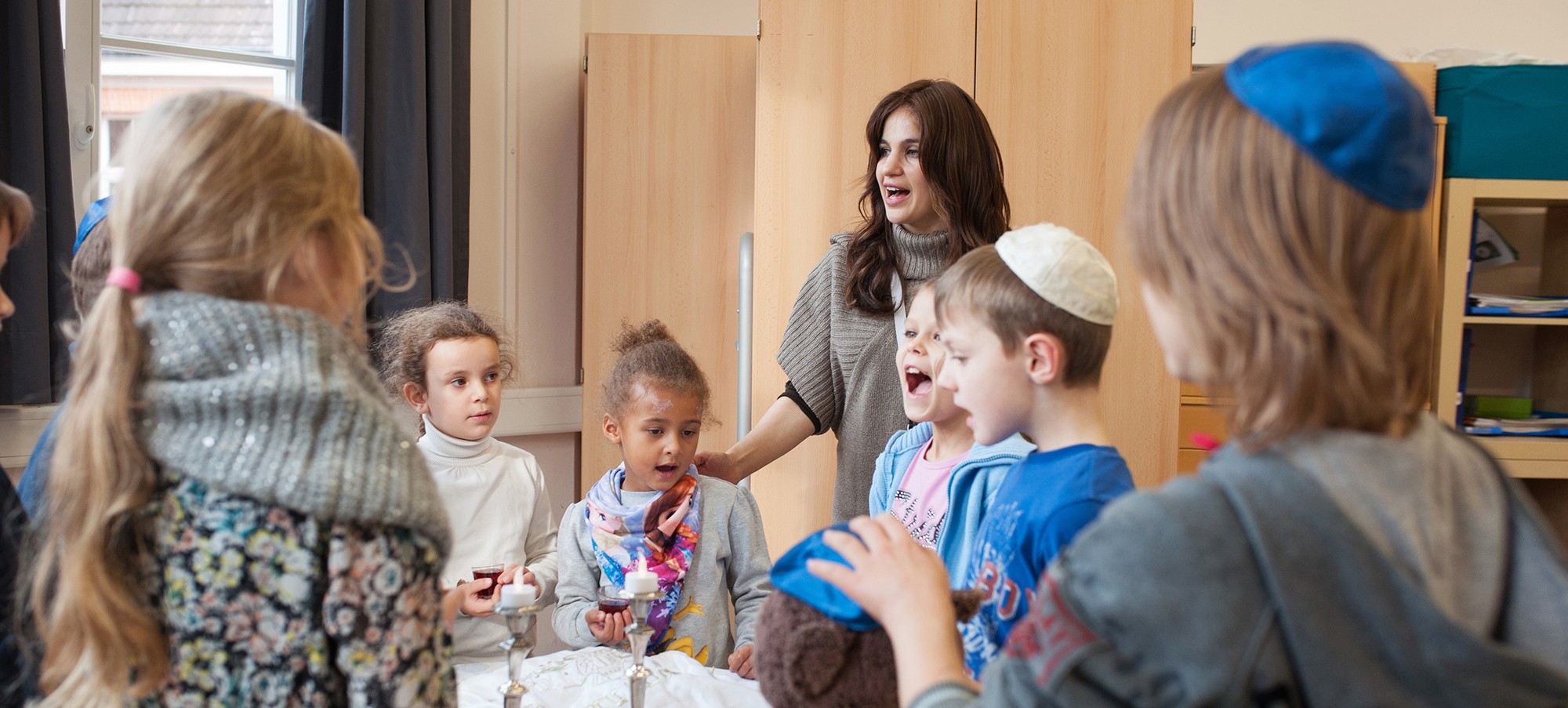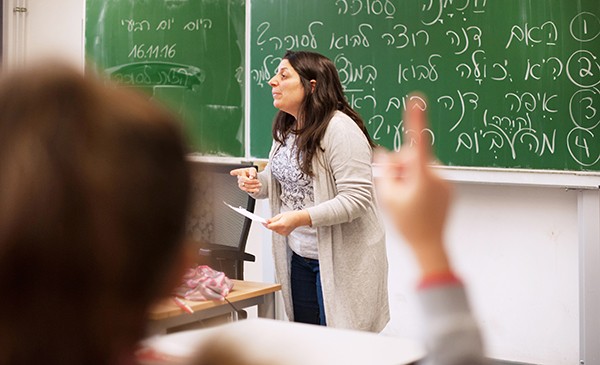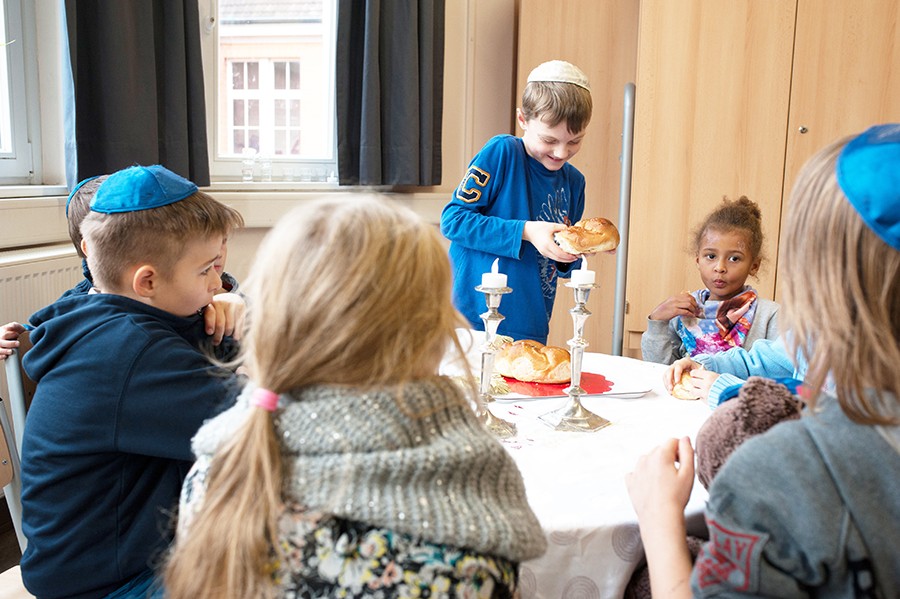

זהות יהודית | Jewish identity
Jüdische Identität
A modern jewish education seeks to preserve as well as hand down jewish values and traditions in accordance with an open-minded 21-century worldview. This basic premise is deeply rooted not only in the pedagogical concept of our Bildungshaus, but it is also clearly visible in everyday-life at the Joseph Carlebach School.
Life here is shaped by jewish traditions, laws and customs. The children are offered their very own access to education in order to fully explore their potential. Therein the introduction to shared values is of crucial importance.
Our school is open to everyone – regardless of religion, origin or gender.
Hebrew for everyone
On the elementary level our compulsory Hebrew courses are based on the TaL AM program. This computer-based language course is grounded upon a Hebrew language and jewish heritage curriculum. Many jewish schools in the U.S. and Europe have successfully implemented this program. It was developed by the Canadian Bronfman Jewish Education Center. The program draws on an immersive attempt at learning languages. Students are immersed in Hebrew through a broad variety of simulated situations in which they can interact using the language.

Religious education
All pupils are obligated to take the class “Jewish Religious Education“. For this course our school’s own curricula are built upon the official governmental framework curriculum on all levels. In age-appropriate ways teachers will introduce your child to the jewish religion and a jewish understanding of faith.
Jewish holidays
For some of the jewish holidays the school remains closed. As a consequence our holiday schedule slightly deviates from Hamburg’s official school holidays. Background and specifics of each festival are taught in class and introduced through creative innovative methods. At the end of the civil year Chanukkah always presents a special highlight.
Exact dates can be found in the current school planer, which is handed out to all pupils.

Jewish holidays / school holidays of the JCSH in 2021
1st Seder
Passover, 1st day
Passover, 2nd day
Passover, 7th day
Passover, 8th day
Erev Shavuot
Shavuot, 1st day
Shavuot, 2nd day
Erev Rosh Hashana
Rosh Hashana, 1st day
Sat., 27.03.2021
Sun., 28.03.2021
Mon., 29.03.2021
Sat., 03.04.2021
Sun., 04.04.2021
Son., 16.05.2021
Mon., 17.05.2021
Tue., 18.05.2021
Mon., 06.09.2021
Tue., 07.09.2021
Rosh Hashana, 2nd day
Erev Yom Kippur
Yom Kippur
Erev Sukkot
Sukkot, 1st day
Sukkot, 2nd day
Erev Shemini Atzeret
Shemini Atzeret
Simchat Torah
Chanukkah
Wen., 08.09.2021
Wen., 15.09.2021
Thur., 16.09.2021
Mon., 20.09.2021
Tue., 21.09.2021
Wed., 22.09.2021
Mon., 27.09.2021
Tue., 28.09.2021
Wed., 29.09.2021
29.11.-06.12.2021
Seasons of joy – Jewish holidays
Rosh Hashana
Rosh Hashana marks the beginning of the jewish year. Usually the festival is in September or October. The year starts off with tens days of solemn introspection. During this time the sound of the shofar (the ram’s horn) can be heard in every synagogue. As a symbol of our hope for a sweet and happy year we dip apple slices in honey. The custom of eating apples dipped in honey expresses our wish that the new year should be just as sweet.
Yom Kippur
Yom Kippur – the holiest day of the jewish year The tenth day after Rosh Hashana is a fast day. We spent the whole day immersed in prayer. We pray for repentance, our return to G-d, and atonement. We seek forgiveness for our sins. Yom Kippur and the time of introspection culminate in one final blast of the shofar.
Sukkot
Sukkot, commonly known as the Feast of Tabernacles, marks the end of the grape harvest season. Yet, above all, the festival reminds us of the Exodus from Egypt as well as the desert wandering of the Jewish people when we dwelled in simple huts. Back then people had to build huts from wood and branches. Just like them we build our huts today from wood, cloth and leaves in a way that the stars can be seen through the roof. We should live, eat, and sleep in the Sukkah for the whole timespan of eight days (in diaspora). In Hamburg’s weather and temperatures this is not an easy task.
Simchat Torah
Simchat Torah is the end of Sukkot. It translates as “Joy of the Torah.” All of the Torah scrolls are taken out of the ark and we dance with the scrolls through the synagogue. This day marks the end and the new beginning of the weekly Torah readings. Everyone is in high spirits, the children look forward to lots of candy.
Chanukkah
Chanukkah, the festival of lights, commemorates the re-dedication of the Holy Temple in Jerusalem after the city was liberated from Greek rule by the Maccabees. Yet the pure oil needed for the seven-lamped candelabra in the Temple would have only been enough for one day. Miraculously the flames of the candelabra burned for eight whole days – enough time to produce new pure oil. On each of the eight consecutive nights of Chanukkah one light is lit on the eight-branched Chanukkiah. Until all eight lights shine on the eighth night of Chanukkah. On Chanukkah we sing happy songs, we eat sufganiot (doughnuts), and play with a sevivon (dreidel). And there is always presents for the children.
Tu Bishvat
The “New Year of the Trees” is celebrated by eating the most beautiful and delicious fruits. We place special emphasis on the seven species for which the land of Israel is praised. Through this we learn the importance of plants in our lives.
Purim
Purim commemorates the saving of the jewish people from Haman, a Persian Empire official, with the help of Queen Esther. The Megillat Esther (the Esther scroll) is read in synagogues. Each time Haman’s name is mentioned the congregation makes thunderous noise with Purim graggers, blotting out his name. Masquerade, giving charity, providing food for the elderly and poor, inviting friends and eating hamantaschen (triangular filled cookies) are all Purim customs.
Passover
Passover is one of three Pilgrimage Festivals – along with Sukkot and Shavuot Passover commemorates the Exodus from Egypt. Moses led the Jewish people from bondage to freedom. In the haste of fleeing from slavery there was not enough time to bake leavened bread. By eating Mazzot, unleavened bread, we commemorate these times. For eight days we abstain from all leavened food, such as bread or pasta. The highlights of Passover are the Seder-Nights which take place on the first and second night of the festival. Most of people hold them at home with friends and family. We read the Haggadah, the story of our journey from slavery to freedom. The youngest member of the family poses four essential questions in the song “Ma Nishtana.” Each of these questions finds its answer in the course of the evening. It is a beautiful holiday with lots of singing.
Shavuot
Shavuot, the Feast of Weeks, is celebrated 50 days after Passover. It commemorates the giving of the Torah on Mount Sinai. The Ten commandments are at the centre of the Torah reading on Shavuot. Herein the congregation reaffirms the covenant between G-d and the jewish people. On Shavuot we also read the Book of Ruth. Many religious Jews spend the night learning Torah. In addition, many rabbis give lectures on Torah subjects.
As a festival Shavuot furthermore marks the fruit harvest. On Shavuot we eat all kinds of dairy food like cheese-cake, milk is the preferred beverage. Of course, ice cream is very popular too.
